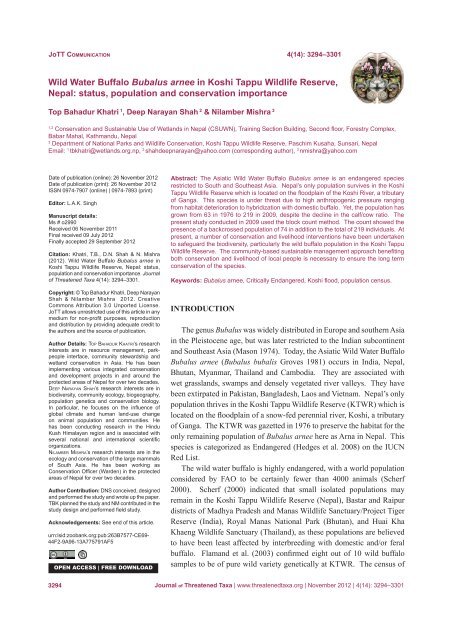View - Journal of Threatened Taxa
View - Journal of Threatened Taxa
View - Journal of Threatened Taxa
Create successful ePaper yourself
Turn your PDF publications into a flip-book with our unique Google optimized e-Paper software.
JoTT Co m m u n ic a t i o n 4(14): 3294–3301Wild Water Buffalo Bubalus arnee in Koshi Tappu Wildlife Reserve,Nepal: status, population and conservation importanceTop Bahadur Khatri 1 , Deep Narayan Shah 2 & Nilamber Mishra 31,2Conservation and Sustainable Use <strong>of</strong> Wetlands in Nepal (CSUWN), Training Section Building, Second floor, Forestry Complex,Babar Mahal, Kathmandu, Nepal3Department <strong>of</strong> National Parks and Wildlife Conservation, Koshi Tappu Wildlife Reserve, Paschim Kusaha, Sunsari, NepalEmail: 1 tbkhatri@wetlands.org.np, 2 shahdeepnarayan@yahoo.com (corresponding author), 3 nmishra@yahoo.comDate <strong>of</strong> publication (online): 26 November 2012Date <strong>of</strong> publication (print): 26 November 2012ISSN 0974-7907 (online) | 0974-7893 (print)Editor: L.A.K. SinghManuscript details:Ms # o2990Received 06 November 2011Final received 09 July 2012Finally accepted 29 September 2012Citation: Khatri, T.B., D.N. Shah & N. Mishra(2012). Wild Water Buffalo Bubalus arnee inKoshi Tappu Wildlife Reserve, Nepal: status,population and conservation importance. <strong>Journal</strong><strong>of</strong> <strong>Threatened</strong> <strong>Taxa</strong> 4(14): 3294–3301.Copyright: © Top Bahadur Khatri, Deep NarayanShah & Nilamber Mishra 2012. CreativeCommons Attribution 3.0 Unported License.JoTT allows unrestricted use <strong>of</strong> this article in anymedium for non-pr<strong>of</strong>it purposes, reproductionand distribution by providing adequate credit tothe authors and the source <strong>of</strong> publication.Author Details: To p Ba h a d u r Kh a t r i’s researchinterests are in resource management, parkpeopleinterface, community stewardship andwetland conservation in Asia. He has beenimplementing various integrated conservationand development projects in and around theprotected areas <strong>of</strong> Nepal for over two decades.De e p Na r a y a n Sh a h’s research interests are inbiodiversity, community ecology, biogeography,population genetics and conservation biology.In particular, he focuses on the influence <strong>of</strong>global climate and human land-use changeon animal population and communities. Hehas been conducting research in the HinduKush Himalayan region and is associated withseveral national and international scientificorganizations.Ni l a m b e r Mis h r a’s research interests are in theecology and conservation <strong>of</strong> the large mammals<strong>of</strong> South Asia. He has been working asConservation Officer (Warden) in the protectedareas <strong>of</strong> Nepal for over two decades.Author Contribution: DNS conceived, designedand performed the study and wrote up the paper.TBK planned the study and NM contributed in thestudy design and performed field study.Acknowledgements: See end <strong>of</strong> this article.urn:lsid:zoobank.org:pub:263B7577-CE69-44F2-9A96-13A775791AF5OPEN ACCESS | FREE DOWNLOADAbstract: The Asiatic Wild Water Buffalo Bubalus arnee is an endangered speciesrestricted to South and Southeast Asia. Nepal’s only population survives in the KoshiTappu Wildlife Reserve which is located on the floodplain <strong>of</strong> the Koshi River, a tributary<strong>of</strong> Ganga. This species is under threat due to high anthropogenic pressure rangingfrom habitat deterioration to hybridization with domestic buffalo. Yet, the population hasgrown from 63 in 1976 to 219 in 2009, despite the decline in the calf/cow ratio. Thepresent study conducted in 2009 used the block count method. The count showed thepresence <strong>of</strong> a backcrossed population <strong>of</strong> 74 in addition to the total <strong>of</strong> 219 individuals. Atpresent, a number <strong>of</strong> conservation and livelihood interventions have been undertakento safeguard the biodiversity, particularly the wild buffalo population in the Koshi TappuWildlife Reserve. The community-based sustainable management approach benefitingboth conservation and livelihood <strong>of</strong> local people is necessary to ensure the long termconservation <strong>of</strong> the species.Keywords: Bubalus arnee, Critically Endangered, Koshi flood, population census.IntroductionThe genus Bubalus was widely distributed in Europe and southern Asiain the Pleistocene age, but was later restricted to the Indian subcontinentand Southeast Asia (Mason 1974). Today, the Asiatic Wild Water BuffaloBubalus arnee (Bubalus bubalis Groves 1981) occurs in India, Nepal,Bhutan, Myanmar, Thailand and Cambodia. They are associated withwet grasslands, swamps and densely vegetated river valleys. They havebeen extirpated in Pakistan, Bangladesh, Laos and Vietnam. Nepal’s onlypopulation thrives in the Koshi Tappu Wildlife Reserve (KTWR) which islocated on the floodplain <strong>of</strong> a snow-fed perennial river, Koshi, a tributary<strong>of</strong> Ganga. The KTWR was gazetted in 1976 to preserve the habitat for theonly remaining population <strong>of</strong> Bubalus arnee here as Arna in Nepal. Thisspecies is categorized as Endangered (Hedges et al. 2008) on the IUCNRed List.The wild water buffalo is highly endangered, with a world populationconsidered by FAO to be certainly fewer than 4000 animals (Scherf2000). Scherf (2000) indicated that small isolated populations mayremain in the Koshi Tappu Wildlife Reserve (Nepal), Bastar and Raipurdistricts <strong>of</strong> Madhya Pradesh and Manas Wildlife Sanctuary/Project TigerReserve (India), Royal Manas National Park (Bhutan), and Huai KhaKhaeng Wildlife Sanctuary (Thailand), as these populations are believedto have been least affected by interbreeding with domestic and/or feralbuffalo. Flamand et al. (2003) confirmed eight out <strong>of</strong> 10 wild buffalosamples to be <strong>of</strong> pure wild variety genetically at KTWR. The census <strong>of</strong>3294<strong>Journal</strong> <strong>of</strong> <strong>Threatened</strong> <strong>Taxa</strong> | www.threatenedtaxa.org | November 2012 | 4(14): 3294–3301

















